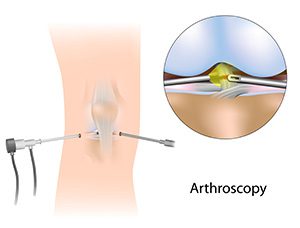One of the most commonly used, and commonly injured, areas of the body is the knee. This joint is used to run, jump, bike, turn, pivot, and many more movements often utilized in recreational activities. When problems develop, there are many ways to identify the issue and to correct it. One of the most advanced techniques that can be used to perform both actions is called arthroscopic knee surgery, or knee arthroscopy. This procedure is a minimally invasive method of evaluating an injury and treating it. Small incisions, rather than one large one, are used and a special type of camera, called an arthroscope, is inserted. The internal images are displayed on a screen so the orthopaedic surgeon can view them clearly and use the information as a guide. Smaller incisions typically mean a shorter recovery, less risk of complications, and reduced scarring. Our extensively trained team can help you determine if knee arthroscopy can be used to address your knee concerns.
Benefits of Knee Arthroscopy
Knee arthroscopy can be used to repair a wide range of injuries, including ACL tears and total knee replacement. This technique can also be used to explore an injury to determine the cause of the pain. Other benefits of knee arthroscopy include:
- Discovering a more accurate diagnosis
- Repairing damage quickly and efficiently
- Causing less damage to surrounding areas
- Reducing post-surgical pain and recovery
- Shortening the length of the hospital stay
- Reducing scarring
We customize every treatment plan to best suit the needs of the individual. During your initial consultation, we will discuss your symptoms, review your medical history, and talk about whether knee arthroscopy may be right for you.
What Happens During Knee Arthroscopy?
 You and your surgeon will determine whether regional or general anesthesia should be used before the surgery takes place. Several small incisions will be made, and the surgeon will insert an arthroscope into one of them to view the interior knee structures. Other instruments are inserted through the other incisions and used to explore the structures and to repair any damage that is found. In many cases, treatment can be performed at the same time as the diagnostic surgery. Multiple conditions can be addressed, if other tissues have been affected by the injury or concern. Once complete, the incisions will be sutured and a bandage will be placed to protect the site.
You and your surgeon will determine whether regional or general anesthesia should be used before the surgery takes place. Several small incisions will be made, and the surgeon will insert an arthroscope into one of them to view the interior knee structures. Other instruments are inserted through the other incisions and used to explore the structures and to repair any damage that is found. In many cases, treatment can be performed at the same time as the diagnostic surgery. Multiple conditions can be addressed, if other tissues have been affected by the injury or concern. Once complete, the incisions will be sutured and a bandage will be placed to protect the site.
Recovery from Knee Arthroscopy
Knee arthroscopy is typically an outpatient procedure, which means you should be able to go home the same day. Depending on whether your treatment was exploratory or planned, the recovery period may vary. Swelling, bruising, and minor discomfort are to be expected, and pain can be managed with prescription medication. You may need some help performing certain actions in the beginning, and we can provide some tips on how to deal with everyday chores and activities. Physical therapy is an essential part of the healing process. You will begin exercises and stretches soon after the procedure, with a rehabilitative program tailored to your needs and progress. Your surgeon will let you know when you can return to your normal schedule, including work.
If you would like to learn more about knee arthroscopy, or if you have additional questions pertinent to your current knee condition, please contact our practice to schedule a consultation.
